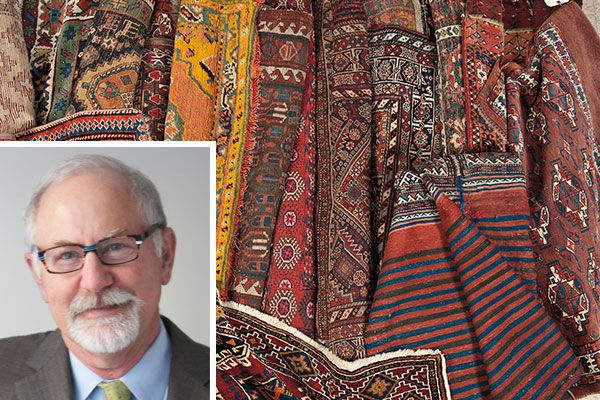
American author Edgar Allan Poe is best known for his mournful poetry and eerie short stories. He also had plenty to say about what we today call interior design. In an 1840 essay about interior decorating, Poe states, “A carpet is the soul of the apartment.”
Stephen Fletcher, the executive vice president, chief auctioneer, and director of the Americana department of Skinner Inc., an international auction house, says that Poe’s observation is still true. Widely regarded as one of the world’s foremost experts on early American furniture, American decorative arts and folk art, Fletcher is also a popular appraiser on the PBS television series Antiques Roadshow.
Here, Fletcher looks back at how floor coverings were used to set the tone of a room in early American history.
Floor Patterns in Sand
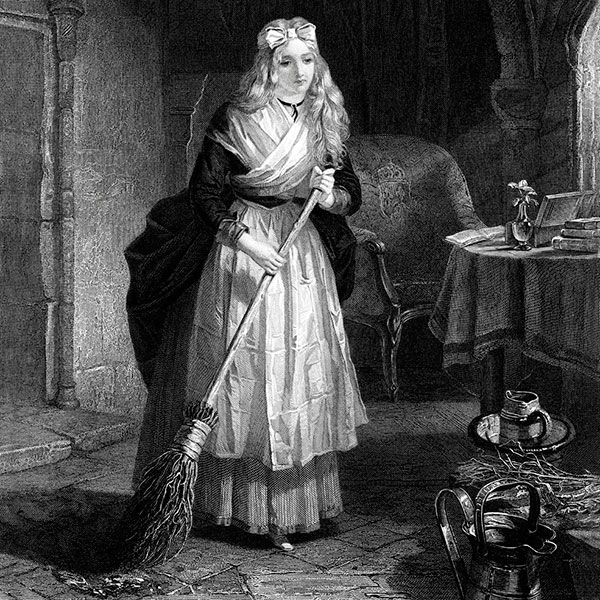
In 17th-century America, resourceful housewives found an ingenious way to add visual interest to their homes. They would pour clean sand over bare floors and use brooms to create intricate patterns in the grains. This frugal yet stylish practice allowed them to express their creativity and enhance their living spaces without the expense of woven rugs.
The sand patterns were not only decorative but also served a practical purpose. They helped absorb dirt and spills, making cleaning easier. This technique was particularly popular in coastal areas where sand was readily available. These ephemeral works of art reflect both the resourcefulness and the aesthetic sensibilities of early American homemakers, showcasing how simple materials could be transformed into captivating designs.
Shown: Sample of a bare floor with sand
Painted Wood Floors
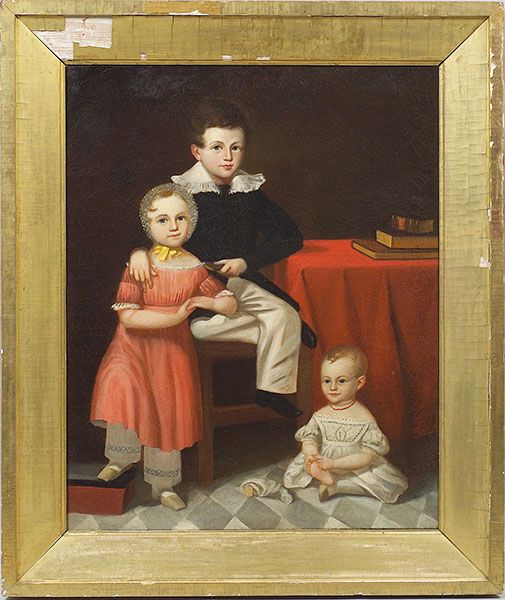
As sawmills became more prevalent in early America, wooden floorboards became increasingly accessible. Homeowners began painting these boards to add color and design to their rooms. One popular motif was alternating black and white squares, mimicking the elegant marble floors found in grand European homes.
These painted floors offered several advantages. They were more durable than bare wood, easier to clean, and provided an affordable way to achieve a sophisticated look. The practice of painting wood floors continued well into the 19th century, with more elaborate designs and color schemes emerging over time. The custom of painting wooden floors illustrates how aesthetics and practicality often intersect in home design, highlighting the evolving tastes and preferences of homeowners.
Shown: American School/Albany, New York Area, 19th Century, Portrait of Three Children, 1835-1845 (Skinner Auction 2242, Lot 26, Sold for: $22,325)
Floorcloths With Geometric Designs
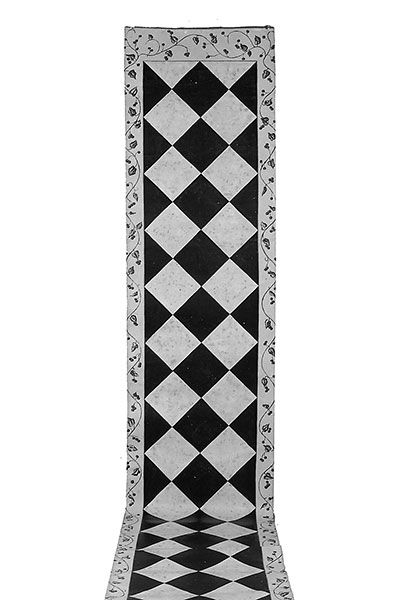
The 18th century saw the rise of floorcloths, heavy canvas coverings painted with colorful geometric designs or swirling marble patterns. These durable and practical floor coverings gained popularity in American homes, offering an alternative to expensive imported carpets.
Some floorcloth patterns drew inspiration from Oriental carpets, which were beginning to make their way into well-to-do homes. This fusion of Eastern and Western design elements created unique, distinctly American floor coverings that reflected the country’s growing cultural diversity. Floorcloths were not only visually appealing but also functional, as they could be easily cleaned and maintained.
Shown: Painted Canvas Runner, America, 19th century (Skinner Auction 2011, Lot 187, Sold for: $861)
The “Turkey” Carpet
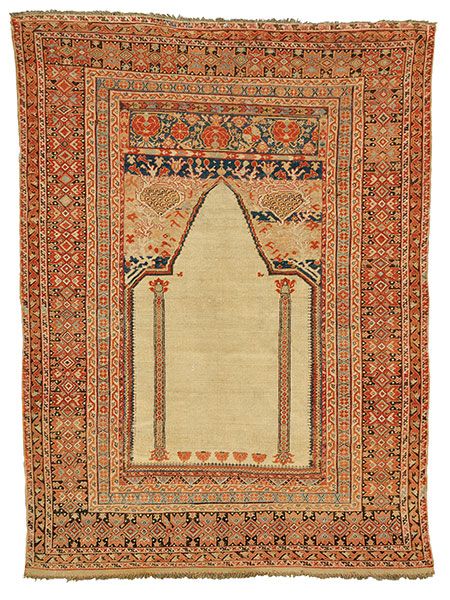
Oriental rugs, often referred to as “Turkey” carpets, were highly prized possessions in early American homes. However, their exorbitant cost and delicate nature made them too valuable to be used as floor coverings in homes with unpaved, dirty streets nearby.
Instead, proud owners would display these luxurious carpets by draping them over tables. This practice not only protected the rugs but also allowed them to be admired as works of art. The display of Oriental rugs became a symbol of wealth and sophistication in American homes. The allure of these exquisite textiles added an exotic touch to interiors, symbolizing the owner’s worldly connections and refined taste.
Shown: Ghiordes Prayer Rug, West Anatolia, late 18th century (Skinner Auction 2845B, Lot 149, Estimate $4,000–$5,000)
“Rag” Rugs
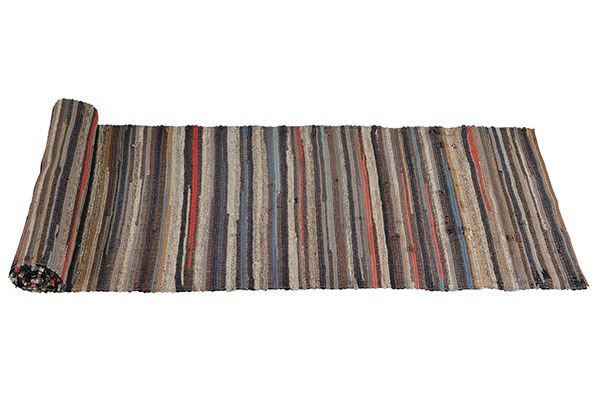
For most American households, homemade “rag” rugs were a more common and practical choice. These rugs were crafted by weaving multicolored scraps of wool fabric on a handloom. As machine-made textiles became more affordable and readily available in the 1840s and 1850s, rag rugs grew increasingly colorful and diverse in their designs.
Rag rugs were not only economical but also environmentally friendly, as they repurposed worn-out clothing and textiles. This tradition of creating beauty from discarded materials continues to inspire modern sustainable design practices. The versatility and charm of rag rugs lie in their ability to inject color and personality into any room, reflecting the creativity and ingenuity of their makers.
Shown: Rag Hallway Runner Rug, America, mid to late 19th century (Skinner Auction 2838M, Lot 1322, Sold for: $1,230)
Hooked Rugs

In the 1840s, hooked rugs gained prominence. The availability of strong, loosely woven burlap fabric made from jute fiber provided an ideal foundation for this new technique. Housewives would use a small hook to pull narrow strips of fabric through the burlap backing, creating intricate designs.
Hooked rugs offered several advantages over their predecessors. They could be made in larger sizes than traditional scrap hearth rugs and allowed for greater creative freedom in patterns. Motifs ranged from conventional flowers and geometric shapes to patriotic scenes and whimsical creations, reflecting the diverse tastes and values of American households.
Shown: Large “Home Sweet Home” Hooked Rug, America, late 19th century (Skinner Auction 2838M, Lot 337, Sold for: $1,968)
Designer Rugs
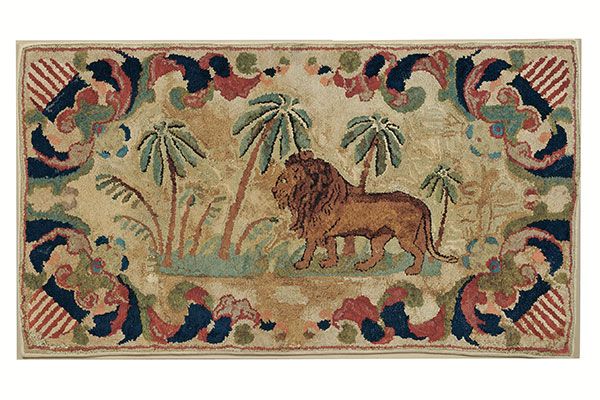
The 1860s marked a significant shift in rug-making with the introduction of professionally designed patterns. These patterns were stamped or stenciled onto burlap backgrounds, allowing for more consistent and intricate designs.
Edward Sands Frost, a New England merchant, pioneered this approach by starting a successful business creating stencil patterns for rugs. Frost’s designs became highly sought after, and surviving examples of his work are now prized by collectors and historians alike. His contributions laid the groundwork for the commercial rug-making industry, which seamlessly blended craftsmanship with artistic innovation.
Shown: “Frost Pattern” Pictorial Hooked Rug with Lion and American Shields, design attributed to Edward Sands Frost (1843-1894), Lyman, Maine (Skinner Auction 2608M, Lot 1313, Sold for: $1,185)
Ingrain Carpets
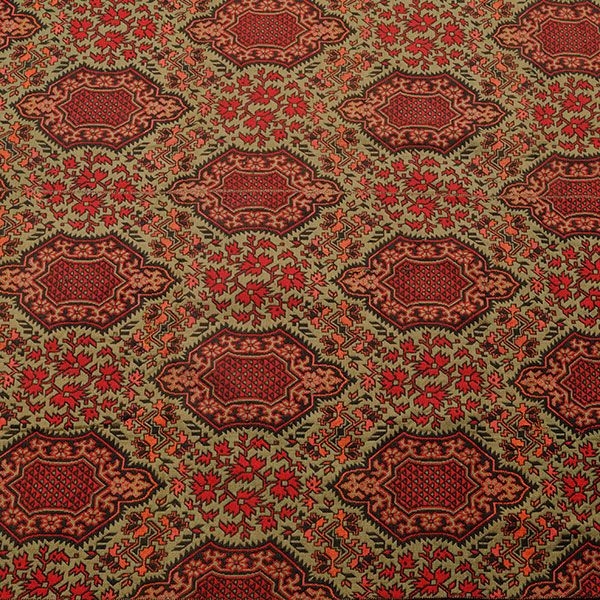
The late 1700s saw a revolutionary development in floor coverings: the ingrain carpet. These bold, flat-pile wool carpets were produced on advanced looms capable of creating elaborate geometric and floral patterns. The most popular colors for ingrain carpets were red, yellow, and green, reflecting the vibrant tastes of the era.
Machine-made ingrain carpets were relatively affordable, making them accessible to middle-class homes. Their popularity endured well into the 1800s, bridging the gap between handmade rugs and mass-produced carpeting. The diverse designs and availability of ingrain carpets contributed to the democratization of stylish home décor, offering aesthetic appeal to a broader range of households.
Shown: Room-size Woven Wool Ingrain Carpet, mid 19th century (Skinner Auction 2669M, Lot 598, Sold for: $420)
Oriental Rugs
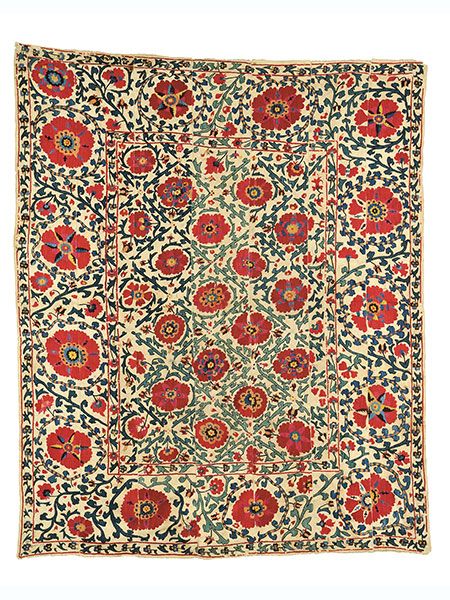
While Oriental rugs had been admired in America for centuries, they did not become widely used as floor coverings until the latter half of the 19th century. These handwoven masterpieces from the Middle East offered an unparalleled variety of colors and patterns, adding exotic flair to American interiors.
The increasing availability and affordability of Oriental rugs coincided with a growing interest in global design and culture among American consumers. This trend continues to influence interior design choices today, with Oriental rugs remaining a popular option for those seeking to add a touch of timeless elegance to their homes.
Shown: Kermina Suzani, Uzbekistan, mid-19th century (Skinner Auction 2845B, Lot 187, Estimate $4,000–$5,000)
The Evolution of Rug Materials
As rug-making techniques evolved, so did the materials used in their construction. Early rugs were primarily made from wool, cotton, and plant fibers like jute and sisal. The Industrial Revolution brought synthetic fibers such as nylon and polyester, offering new possibilities for durability and affordability.
Today, rug makers combine traditional and modern materials to create floor coverings that suit a wide range of needs and preferences. From eco-friendly options made from recycled materials to luxurious silk and wool blends, the variety of rug materials available reflects our changing lifestyles and values. This evolution mirrors society’s growing emphasis on both sustainability and quality.
